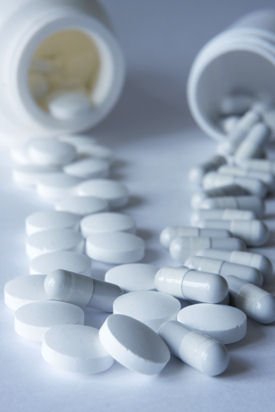Addressing drug interactions when their likelihood is ‘yes'
Once a patient is taking 10 or more drugs, they face drug interactions. Douglas S. Paauw, MACP, addresses the most common problems, including the details of grapefruit juice and statins, thyroid-replacement therapy, proton pump inhibitors and warfarin.
How do you know if your patient is at risk for a drug interaction? Douglas S. Paauw, MACP, has one easy rule of thumb. “Once somebody is on more than 10 drugs, the likelihood of a drug interaction is ‘Yes,’” he told attendees of a precourse at Internal Medicine 2009.
Even patients taking fewer drugs risk serious harm from some common interactions and side effects, he noted. The session reviewed a few of those issues most likely to come up in an internal medicine practice.

There are quite a few drugs that interfere with the absorption of thyroid-replacement therapy, for example. If a patient undergoing therapy has a sudden increase in thyroid-stimulating hormone, the culprit could be iron or calcium supplements, a binder like sucralfate or cholestyramine, or a proton pump inhibitor (PPI).
“Anything that decreases stomach acid can affect thyroid hormone,” said Dr. Paauw. A number of potential problems with PPI use have come up recently, including decreased absorption of calcium, iron and antifungals and an increased risk of Clostridium difficile.
“We're seeing more and more of a push to limit our PPI use. We should put them on the lowest dose that gets the job done,” he said.
Aiming for a low dose is also appropriate in statin therapy, Dr. Paauw said, acknowledging that cardiologists might disagree with him.
About 10%-15% of patients suffer muscle pain or weakness on statins, and biopsies have shown that all statin patients, even asymptomatic ones, have muscle cell damage from the drugs. That data gives Dr. Paauw pause about prescribing statins to young patients, too. “My concern is, what is the effect over 40 years if everybody has muscle damage?” he asked.
Statins, particularly simvastatin, also are one of the drugs most likely to interact with grapefruit juice. Even medication timing (pills at night, juice in the morning) does not fully correct for the effect, Dr. Paauw warned. But half a grapefruit or an occasional glass of grapefruit juice is not a problem and several statins (pravastatin, fluvastatin, rosuvastatin, and to a lesser extent, atorvastatin) are not bothered by grapefruit. Also on the list of grapefruit-affected drugs are cyclosporine, saquinavir, benzodiazepines and calcium channel blockers.
But if you're looking for the drugs that can have dramatically bad interactions, watch out for warfarin, Dr. Paauw said. Antibiotics, particularly trimethoprim and sulfamethoxazole, double strength, can have a significant effect on International Normalized Ratio. He also warned about the effects of corticosteroids and acetaminophen on warfarin.
The problem arises with sustained, not occasional, use of acetaminophen, Dr. Paauw noted. “Most of us will tell our patients take acetaminophen for an ache or pain. The problem is when they're taking it regularly.”
Bleeding risk is also something to keep in mind when prescribing selective serotonin reuptake inhibitors (SSRI). Two retrospective studies have shown an increased risk of upper gastrointestinal bleeds in patients who are taking the drugs. The risk is heightened when patients are also taking a non-steroidal anti-inflammatory, and patients who are on both should get some form of gastroprotection, Dr. Paauw said. “We need to stop before putting SSRIs in the drinking water,” he joked.
After an hour of Dr. Paauw's warnings on drug , which also included issues with thiazolidinediones, loop diuretics and bisphosphonates, attendees would likely think twice before putting any drugs in the water.





